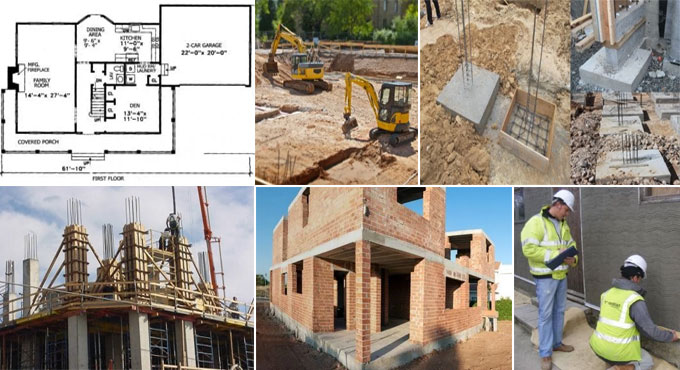
Building Construction Work Sequence
A constructor needs to follow the work sequence carefully. Otherwise, the whole process of building construction might crash. Thus it is very important to maintain and follow the work sequence in building construction carefully. Let us see how it should be done properly.
1. Paper Work: The paperwork for the building needs to be finished even before the work actually begins. This includes:-
a. Preparation of drawings and diagrams
b. Material and construction cost estimation
c. Labor costs and contingency measures
d. Approval of design from local development authority
e. Any other legal work that may be necessary
2. Layout Marking: The plan boundaries need to be marked on the ground. Only the approved plan should be marked down. The ground inside and outside the site should be cleaned of any undesirable elements. Accurate dimensions and orientations must be followed while marking down the layout.
3. Excavation Work: The foundations of the building need to be placed under the ground level, onto a solid bed. For this, much excavation work needs to be done on site according to design. The wall foundations and column foundations may require different types of foundations. For this reason, different amounts of excavation may need to be done.Suitable machinery like dozers need to be used for large scale excavation. Not only that, you need to carry off the excavated earth to a suitable location as well.
4. Foundation Work: The foundation needs to be done via the following steps:
a. Compacting the ground
b. PCC
c. Footing Reinforcement
d. Shuttering
e. Footing concrete
5. Column Casting: To cast the columns, first make the shuttering framework. After this, pour the ready concrete mix in the framework. Then you need to let it harden for a while. This depends upon the type of concrete you have used and the sort of load the column needs to bear. After proper curing, remove the framework to expose the ready column.
6. Wall Construction: Depending upon the architectural design, walls can vary in content. A wall can be made of bricks, precast blocks, wood, and other materials.
Of course, before starting a wall, the proper footing for it needs to be done. The wall footings are made up of concrete or stone foundations. The wall then needs to be casted using the prescribed material up to the floor height. Necessary openings for windows, doors and other openings must be provided.
7. Lintel: Reinforced concrete beams are laid down on top of the openings of doors and windows. These beams are called Lintels. These ensure that the weight of the structure above the opening distributes on the sides of the openings.
8. Roofing: After completion of masonry work, roof slabs are poured. Nowadays much of the roofing work is done by using precast concrete slabs. The thickness and reinforcements inside the slabs depend upon the design requirements and the amount of load it is expected to bear.
9. Plastering Work: You need to wait 14 days after all basic building work is done. This lets the construction bond properly and harden. Then, the plastering work starts. Generally 1:3 or 1:4 ratio mortar is used for plastering. The thickness of the plaster needs to be kept below 0.75 mm and above 0.50 mm. After plastering a surface, you also need to cure the surface for a week or so. This will let the plaster gain strength and bond with the surface properly.
10. Extra-construction work: Up to this point, the actual construction work is done. After this, extra work for the building needs to be done. These include:

a. Fixing of doors and windows
b. Fixing grills and railings
c. Waterproofing terraces and other surfaces
d. Electrical and plumbing work
e. Floor tiling and/or finishing
f. Painting and other decor
g. Landscaping
h. Woodwork

